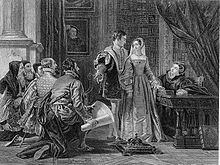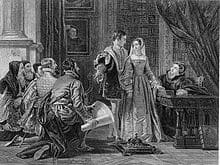
This day in history launched the scheme that would lead to the execution of John Dudley, the man who had clawed his way back up the political ladder after his father’s execution for treason in 1509 and somehow made it to the very top as Duke of Northumberland and President of Edward VI’s Privy Council (making him the de facto leader of England as Edward was still a minor).
But first we need to back up about three months – to February 1553, when Edward VI had fallen ill – seriously enough that he had started to consider what would happen if he died. Under the Act of Succession adopted during his father’s reign, Edward’s Catholic sister Mary would inherit the throne – which the ardently Protestant boy king wanted to avoid at any cost. Edward came up with his own “Devise for the Succession” in which the crown would bypass both his sisters, Mary and Elizabeth and go straight to Lady Jane Grey, whose claim arose through Henry VIII’s youngest sister. Unfortunately for Edward (and Northumberland!), his Devise was not ratified by Parliament and therefore could not legally supersede the former king’s policy.
Still, Northumberland sprang into action to profit from the action he hoped to shove down the country’s throat: on May 25, he married his son Guildford to Lady Jane Grey (since both were under eighteen, Northumberland would maintain his role as President of the Council). Of course, he needed allies for the scheme to work – so on this same day he also married his daughter Katherine to Henry Hastings (heir to the Earldom of Huntingdon), and had Catherine Grey marry Lord Herbert, the heir to the Earldom of Pembroke. These unions gave him powerful and committed support.
The weddings themselves were celebrated with the pomp that was to be expected for a royal marriage: a magnificent festival was held, with jousts, games, and masques. Guests included most of the highest nobles of the court, the Venetian and French ambassadors, and even “large numbers of the common people.” (In what with hindsight could be considered foreshadowing, Guildford and some others suffered an attack of food poisoning, blamed on “a mistake made by a cook, who plucked one leaf for another.”)
Six weeks later, Edward VI was dead and Northumberland proclaimed Jane Grey to be Queen of England. Jane and Guildford made their ceremonial entrance to the Tower…then never emerged. Mary, too, proclaimed herself Queen – and thousands of Englishmen flocked to her banner. Northumberland was forced to surrender and was quickly executed, while Jane and Guildford were pardoned by a magnanimous Mary I – though not released. Unfortunately, they were condemned when opposition to Mary’s planned marriage to Philip of Spain resulted in the Wyatt Rebellion. While the rebels would likely have put Elizabeth on the throne instead of Jane Grey, Jane’s father joined the revolt – flaming the fans of governmental indignation and panic. Mary’s Privy Council unanimously advised execution, and Mary agreed.
Catherine fared a little better – well, she lived longer. Her new husband’s father sought to distance himself from the Grey family when Jane’s accession to the throne failed; he separated the couple and sought annulment of the marriage, which was granted in 1554 on the grounds that it had never been consummated. In 1560, after Elizabeth had come to the throne, Catherine secretly married again – Edward Seymour, Earl of Hertford – and quickly became pregnant. Elizabeth was furious. Convinced that the marriage was part of a conspiracy against her crown, she promptly imprisoned poor Catherine. Catherine and Hertford remained in the Tower for three years, then after the two were permanently separated, Catherine was released but still kept under close confinement until she died of consumption in 1568, aged only 27.
As for Katherine Dudley, she seems to have been politically unaffected by her father’s treason. She went off to live with her husband in the English Midlands and Yorkshire for years, returning to court only in 1595 where she became one of Elizabeth’s closest friends. Definitely the winner of this round!
SOURCES:
Wikipedia – John Dudley, Jane Grey, Guildford Dudley, Edward VI, Catherine Grey, Katherine Dudley
***
If you like my posts, you’ll love my books! My Seymour Saga trilogy tells the gripping story of the short-lived dynasty that shaped the Tudor Era. Jane the Quene skews romantic, The Path to Somerset is pure Game of Thrones (without the dragons), and The Boy King is a noir coming-of-age. Get them now through Amazon, Barnes & Noble, Kobo, and Apple, or even your local independent bookstore!

(PS Already read them? Did you love them? Then please review them – even just a stars rating! It makes a huge difference in helping new readers find them and would mean the world to me!)

Reblogged this on murreyandblue and commented:
M
Re-blogged on Murrey and Blue, with particular reference to Lord Henry Hastings, as he then was …